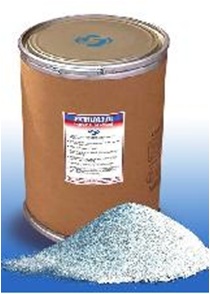Guardian Petrochemicals Absorbent
PetroGuard-D Hyper-immobilizing Solidifying Absorbent For Oil Spills
Model:
PetroGuard-D is used to absorb and solidify liquid hydrocarbons to a recoverable solid, with minimal overall volumetric increase. The most unique and important characteristic of PetroGuard-D is that once absorbed, liquids will not be released, even under pressure. PetroGuard-D is a dry, white granular blend, consisting of unique organic polymeric materials.
PetroGuard-D has a strong affinity for hydrocarbon-based liquids. It has demonstrated a particularly strong attraction for the primary aromatic compounds.
PetroGuard-D has a strong affinity for hydrocarbon-based liquids. It has demonstrated a particularly strong attraction for the primary aromatic compounds.
Key features of the absorbent are:
Example organics absorbed and immobilized
Use
PetroGuard-D is ideally suited as an emergency spill response absorbent because of its rapid immobilizing characteristics. PetroGuard-D will prevent or reduce production of vapors from volatile petroleum products. Absorbed materials are then easily handled and disposed of as a solid, preferably by incineration.
PetroGuard-D is also an ideal product for the control of liquid hydrocarbons during industrial maintenance procedures, such as occur in refining facilities.
For water applications, the primary function of PetroGuard-D is to prevent further migration of any spilled, un-dissolved or floating product. PetroGuard-D can be applied in its &ldquofree form&rdquo directly to the spill either manually or with mechanically assisted devices.
Emergency Response Plan
In situations where the danger of inadvertent spills exists, adequate stores of PetroGuard-D is recommended as an ideal component of established emergency response program. Because of PetroGuard-D&rsquos rapid immobilizing characteristics, it is an ideal product for quick response situations. It is the ideal product for hazardous as well as for many appropriate non-hazardous spill applications. PetroGuard-D is listed in the 2004 SEHSC Emergency Response Manual as &ldquoPolymeric Absorbing Deactivating Powder&rdquo.
Disposal
Spent PetroGuard-D is best disposed of by incineration. Its high BTU value makes PetroGuard-D an excellent candidate for fuel blending. PetroGuard-D has a BTU content more than 19,000 BTU&rsquos per pound, with very little ash residue.
Depending on leaching test (TCLP) requirements, spent PetroGuard-D may also be land filled. However, specific regulations and analytical documentation for landfill disposal should be obtained from the appropriate regulatory agencies (local, state and/or federal). Certain types of cleanup applications may result in the classification of the spent materials as hazardous. In such instances, the material should be disposed of through an approved hazardous waste disposal service with the appropriate documentation
| Hyhobic |
| Non-toxic or polluting |
| Oleophilic |
| Super-absorbent |
| Non-catalytic activity |
| Will not release under pressure |
Example organics absorbed and immobilized
| Crude oil | Heating oils |
| Diesel oil | Gasoline |
| Kerosene | Machine oil |
| Polynuclear aromatic hydrocarbons | Hydraulic oil (not synthetic) |
| Chlorinated hydrocarbons | Jet fuel |
PetroGuard-D is ideally suited as an emergency spill response absorbent because of its rapid immobilizing characteristics. PetroGuard-D will prevent or reduce production of vapors from volatile petroleum products. Absorbed materials are then easily handled and disposed of as a solid, preferably by incineration.
PetroGuard-D is also an ideal product for the control of liquid hydrocarbons during industrial maintenance procedures, such as occur in refining facilities.
For water applications, the primary function of PetroGuard-D is to prevent further migration of any spilled, un-dissolved or floating product. PetroGuard-D can be applied in its &ldquofree form&rdquo directly to the spill either manually or with mechanically assisted devices.
Emergency Response Plan
In situations where the danger of inadvertent spills exists, adequate stores of PetroGuard-D is recommended as an ideal component of established emergency response program. Because of PetroGuard-D&rsquos rapid immobilizing characteristics, it is an ideal product for quick response situations. It is the ideal product for hazardous as well as for many appropriate non-hazardous spill applications. PetroGuard-D is listed in the 2004 SEHSC Emergency Response Manual as &ldquoPolymeric Absorbing Deactivating Powder&rdquo.
Disposal
Spent PetroGuard-D is best disposed of by incineration. Its high BTU value makes PetroGuard-D an excellent candidate for fuel blending. PetroGuard-D has a BTU content more than 19,000 BTU&rsquos per pound, with very little ash residue.
Depending on leaching test (TCLP) requirements, spent PetroGuard-D may also be land filled. However, specific regulations and analytical documentation for landfill disposal should be obtained from the appropriate regulatory agencies (local, state and/or federal). Certain types of cleanup applications may result in the classification of the spent materials as hazardous. In such instances, the material should be disposed of through an approved hazardous waste disposal service with the appropriate documentation
